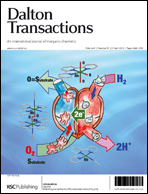DNA binding and antiproliferative activity toward human carcinoma cells of copper(ii) and zinc(ii) complexes of a 2,5-diphenyl[1,3,4]oxadiazole derivative
Abstract
The interaction of calf thymus DNA with [CuL(ClO4)]ClO4·H2O (1) and [ZnLBr]Br·H2O (2) (L = 9,12,15,18,27,28-hexaaza-29-oxatetracyclo[24.2.1.02,7.020,25]enneicosa-2,4,6,20,22,24,26,281-octaene) dicationic complexes in aqueous solution at neutral pH, was investigated by variable-temperature UV-vis absorption, circular dichroism and fluorescence spectroscopy. The values of the DNA-binding constants of these complexes, determined by competitive binding spectrofluorimetric titrations of ethidium bromide (EB)–DNA solutions, are (6.7 ± 0.5) × 106 M−1 for CuL2+ and (4.7 ± 0.5) × 105 M−1 for ZnL2+. These data together with a through analysis of the spectroscopic behaviour consistently suggest that both compounds are effective DNA binders. Interestingly, the DNA-binding strength of these complexes has been found to be correlated to their in vitro cytotoxic activity toward human breast carcinoma cells, although the complex with lower DNA-binding affinity is more active. In fact, biological studies showed that when the compounds are delivered through the cell membrane by a lipidic carrier, the cell survival is sensibly reduced, up to 58% with 1 and to 31% with 2.
![Graphical abstract: DNA binding and antiproliferative activity toward human carcinoma cells of copper(ii) and zinc(ii) complexes of a 2,5-diphenyl[1,3,4]oxadiazole derivative](/en/Image/Get?imageInfo.ImageType=GA&imageInfo.ImageIdentifier.ManuscriptID=C2DT11759B&imageInfo.ImageIdentifier.Year=2012)

 Please wait while we load your content...
Please wait while we load your content...